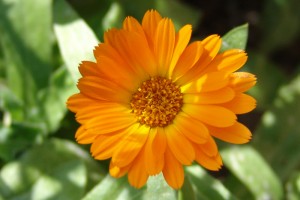
Marigolds are found almost anywhere in the world. They grow easily, bloom reliably, and have few insect and disease problems. Marigolds are highly useful for medicinal purposes such as headaches, toothache, swelling, and strengthening the heart. They have also been used in cooking as well.
History
It is thought that marigold originated in Egypt and was first introduced to Britain and other countries by the Romans. It was one of the earliest cultivated flowers. The ancient Greeks, who used the petals for decoration, also knew of marigold’s other uses, such as coloring for food, make-up, dying fabrics, and medicinal uses. Marigolds have been grown in the gardens of Europe since the 12th century. By the 14th century, many had learned of its many and varied “magical powers.” One medieval author named Macer described marigold in his volume on herbs and thought that merely to look upon the blooms would improve eyesight and draw evil “humors” from the head. They are often called “pot marigolds”due to their use in cooking.
During the American Civil War and World War I, marigolds were used to prevent wounds from getting infected. The blooms were made into either a poultice or infused into oils for application to the wounds. In eastern countries garlands of the brightly colored flowers were, and still are, frequently used in festivals.
Medicinal Uses:
Only the flower heads of marigolds are used medicinally. They are well known for their wound healing and antiseptic properties, but modern herbalists have found a wide variety of uses for them, including: an alternative analgesic, anti-inflammatory, antispasmodic, astringent, bactericide, carminative, depurative, diuretic, emmenagogue, stomachic, styptic, and tonic. The petals of the marigold have been made into an infusion that is useful as an eyewash. They are also good as a natural fabric dye and for food coloring.
Taken Internally:
- Improves circulation
- Balances female reproductive systems with its estrogenic effect—for example in cases of painful or scanty menstruation
- Detoxifies the digestive system, helping to heal viral inflammations, candida, gastritis and peptic ulcers with its anti-bacterial/anti-fungal actions
- Is a safe diuretic that will aid in detoxifying the urinary tract
- Purifies the lymphatic and immune systems as it builds them up
- Helps to treat dysfunctions of the liver and gallbladder and will clear, cool, and detoxify the digestive system and relieves colitis
- Stimulates the cells that protect the body from infection
- Soothing for sore throats, toothaches, and cold sores
- Antiseptic actions will speed up recovery from measles and mumps
Externally:
Compresses soaked in marigold tea are therapeutic in many ways, including:
- Healing wounds, cuts, scrapes, lacerations, small infections of the skin, animal bites, scratches, and scars
- Stops bleeding with its astringent actions
- Anti-bacterial actions combat infection and promote healthy tissue growth
- Anti-inflammatory, reducing swelling and irritation, soothing the treated areas
- Anti-microbial
- Calendula ointment applied to varicose veins twice daily for about three weeks can improve or clear them completely
- Appling marigold ointment and/or powder to bed/pressure sores regularly can treat and may even prevent them if used before the skin breaks down that far
- Marigold ointment is a safe and effective treatment for diaper rash, and used together with fresh air, it is a wonderful solution to an age-old problem. Marigold powder has also been used as a replacement for baby powder, as its healing properties go far beyond anything that talc can do.
- Great for treating bruises
- Ideal for treating sunburn and other first degree burns
- Soothing to insect bites and stings
Marigolds In Pregnancy and Childbirth:
Pregnant women should not use internal preparations as it is believed to stimulate labor and may thus bring on delivery too early. However, it is safe to use it externally throughout pregnancy and may be especially helpful after childbirth. It has long been used to promote healing of rips to the perineum and likewise any incisions needed to allow for the baby’s entry into the world. It can be alternated with arnica treatments or used alone.
Ointment of Marigold on birthing scars has been used to reduce their visibility and using it on sore, cracked nipples due to nursing offers relief to many when gently rubbed into the area. This same ointment is useful for treating mastitis after birth or during breast-feeding. If a high fever develops after childbirth, a diluted tincture of marigold, in combination with a strong infusion, used three times daily will help reduce the fever and flu-like symptoms that may accompany it.
Shelf life of Flowers and Seeds:
Dried flowers can last 6-12 months while fresh flower heads should be used immediately for maximum potency. The seeds under normal conditions will be good 1-2 years, but stored in a cool, dark place in a tightly covered container will last much longer.
______________________________________________________________
Disclaimer: We are not medical professionals. This article is for informational purposes only and not intended as a replacement for medical advice. We always recommend that our readers seek the advice of a licensed physician for any medical condition. Pregnant women should ALWAYS seek the advice of their obstetricians before using any medicine, whether prescription, over the counter, or herbal alternatives.